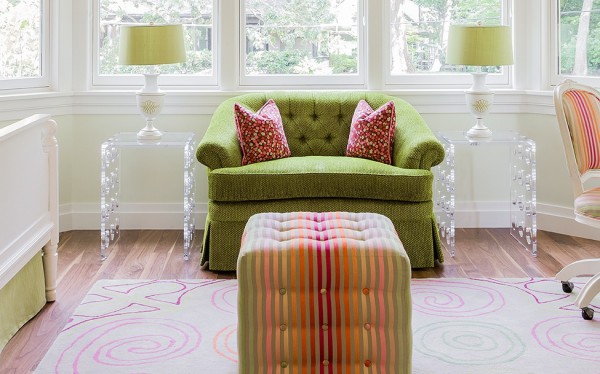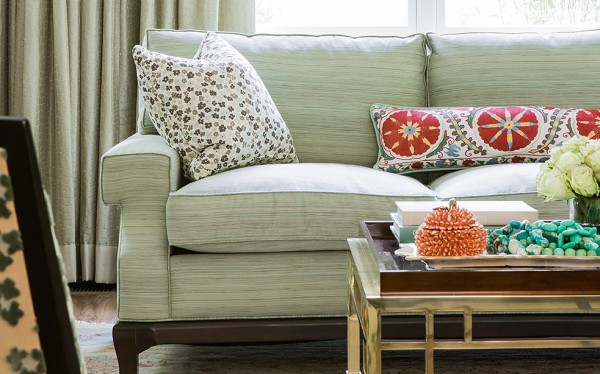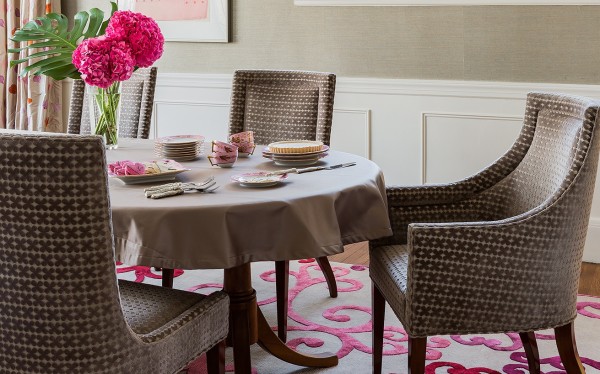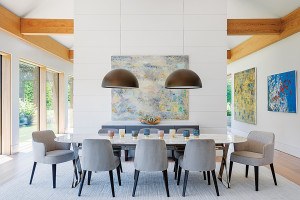10 Questions with Interior Designer Jill Litner Kaplan
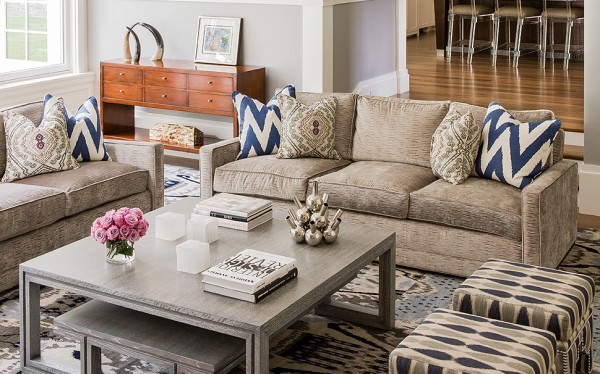
A peek at a living room designed by Kaplan (photos by Michael J. Lee)
From fashion to travel, Jill Litner Kaplan has cultivated a style that’s layered and dynamic. We chatted with the interior designer and found out how to achieve a worldly look without leaving home and why her career is so rewarding.
1. Did your passion for interior design stem from your interest in fashion?
I was always very excited about interior design. Although, my formal training began years ago when I was a buyer for women’s designer sportswear. During that period, I developed a very critical and discerning eye for fabrics. I learned … how to make every store I was working with look uniquely different from the rest. And when I was decorating my own apartment in New York City, and in Boston, and even when I was in business school, I translated all those skills I learned as a buyer to design.
I also have traveled extensively and lived in Paris as a student. When I was living there, I found myself studying the way the French merchandised and how each store was so uniquely different from the rest. So, that was probably the beginning of my love for design. The French are very well traveled, and I loved the fact that there were so many cool, exotic things everywhere I went in Paris. When I went back to New York, I was seeking that in everything I did in the design of my own apartment. I’ve always been a bit of a hunter for unusual things, and that’s always been incorporated into my interiors.
2. You launched JK Creative Retail Solutions, LLC, then decided to focus on interior design. What inspired the switch?
I had actually been part of a female-only start-up called mymaison.com, which was a very revolutionary, dynamic concept way ahead of its time. I was the director of merchandising, and it was exclusively for home furnishings. I was going around the country and listing all these wonderful companies like Restoration Hardware and Shades of Light and talking to all these companies about what we were trying to create. So, I was definitely very entrenched in the world of interiors. But my personal interest in design and my own business was born of demand. I had a lot of experience with home furnishings and merchandising. What made this unique was it was sort of a packaging of everything I had done in my previous career but in a unique, wonderful way where I was working for clients individually.
3. After traveling and living elsewhere, what led you back to Boston?
I left Boston to go to college in New York City, and I was there 16 years. And I came back here to go to Harvard Business School. I had accepted a job in New York City and my fiancé, at the time, had a job offer working at a law firm in Boston. So, we decided it might be a good idea, after getting married, to move to Boston and take, what we thought would be, a sabbatical from New York City. To be honest, we never envisioned staying. But it’s safe to say, at this point—three moves and two kids later—that we are not going back to New York City anytime soon.
4. How do you incorporate your worldly style into your spaces?
The first thing I try to do is have a great deal of collaboration with my client. I try to be very, very intuitive about each of their respective styles. All of my clients are uniquely different, but a lot of them know one another. It’s important to me that every client has a look that’s different from the rest. So, part of what I learned in my travels was that you need to assemble a wonderful assortment of fabrics—I think the fabric palette is the foundation of every room—and I have a voracious appetite for fabrics.
5. What part of your travels have influenced your interior designs the most?
I think New York City is a little microcosm of the entire world. When I go to the New York Design Center, it’s easy to stroll down any of those side streets and feel like I’m in India. I can buy silk saris and make them into pillows. I can go into a wonderful rug store and find something from Iran or Afghanistan. I think New York has many outstanding resources. On of my favorites is a fellow who sells Moroccan furniture on the Lower East Side. And I find really wonderful beads from Africa at my favorite flea market in Chelsea. I think, if you’re resourceful and you go to New York City, it’s possible to identify and source very interesting one-of-a-kind items without buying a plane ticket.
6. What design element would you say is most important?
It is so critically important to finish a space. I have a voracious appetite for fabrication. I also love accessories and love art. To me, a room is not complete without the personality of the homeowner reflected in their possessions. For me, the finishing touches—the accessories and the artwork—are critically important for the completion of any room.
7. What has been the biggest challenge in your career, and how did you overcome it?
A lot of people assume, without speaking to us, that we do exclusively large-scale projects—whether it’s renovations or a new build. However, we do a vast, vast range of projects. And the budgets we work with can be radically, radically dissimilar depending on the client and on the needs of any given project. Sometimes, we are presented with incredibly restricted budgets, and one needs to be incredibly creative. We have to make every dollar stretch. And that is challenging, but I also feel like it challenges us in a very positive way: where we have to be our most creative. So, it’s not a negative, it’s actually a positive. And, sometimes, those projects can be the most fun.
8. How do you achieve a bold, distinct look while still making a space that the client won’t tire of?
We usually do a very neutral palette for wall color because, I think, having distinctive wall colors can be very boring. All of our upholstery pieces have very lasting, enduring fabrications on them. Whereas, the fashion, the pop, the dynamism is in things like pillows, which are more of-the-minute. We rarely install anything that is not timeless. I would say our designs are very timeless and lasting. One of the things we do a lot of, which speaks to this, is children’s rooms. And the key there—the most important fabrics like the window treatments and upholstery—are things the kid will never get sick of, nor will the mother. The more age-appropriate materials can be in pillows or a duvet. But the more investment pieces will last for years and years to come.
9. Do you think it’s better to take risks in design or err on the conservative side?
I believe in a mix. I think are any number of times when our clients have trusted us in order to make those kinds of decisions. I would never want to push a client into taking design risks. That being said, I think it’s all about the mix. I think if you have a very dynamic, engaging, interesting mix of timeless pieces imbued with some other elements that are a little bit riskier, you have to make those decisions based on the client. It’s almost like a risk assessment.
10. What do you count as your greatest accomplishment?
That’s so easy. It’s the relationships we have with our clients. I always feel the success or failure of any design project is a reflection of the relationship we have with our client. To me, I could easily point to any of our projects and say this is my favorite. But, at the end of the day, I really think our relationships with people are what it’s all about. That, to me, is very important—that people tell us how happy they are going home every day.
Check out more by Kaplan below:

